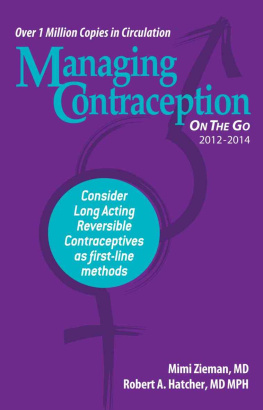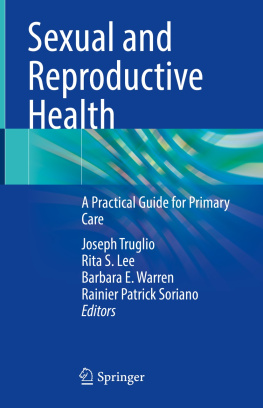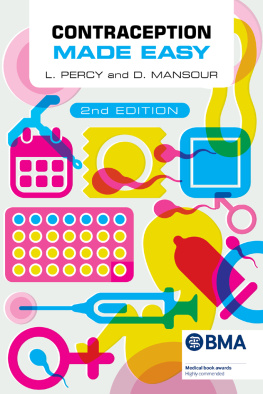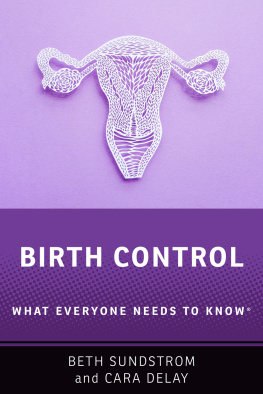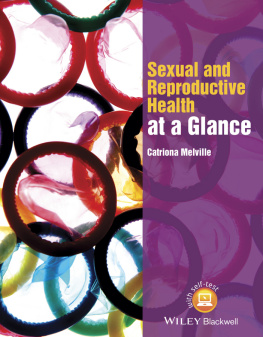Zieman Mimi - Managing Contraception
Here you can read online Zieman Mimi - Managing Contraception full text of the book (entire story) in english for free. Download pdf and epub, get meaning, cover and reviews about this ebook. year: 2012, publisher: Bridging The Gap Communications, genre: Romance novel. Description of the work, (preface) as well as reviews are available. Best literature library LitArk.com created for fans of good reading and offers a wide selection of genres:
Romance novel
Science fiction
Adventure
Detective
Science
History
Home and family
Prose
Art
Politics
Computer
Non-fiction
Religion
Business
Children
Humor
Choose a favorite category and find really read worthwhile books. Enjoy immersion in the world of imagination, feel the emotions of the characters or learn something new for yourself, make an fascinating discovery.
- Book:Managing Contraception
- Author:
- Publisher:Bridging The Gap Communications
- Genre:
- Year:2012
- Rating:4 / 5
- Favourites:Add to favourites
- Your mark:
- 80
- 1
- 2
- 3
- 4
- 5
Managing Contraception: summary, description and annotation
We offer to read an annotation, description, summary or preface (depends on what the author of the book "Managing Contraception" wrote himself). If you haven't found the necessary information about the book — write in the comments, we will try to find it.
Managing Contraception — read online for free the complete book (whole text) full work
Below is the text of the book, divided by pages. System saving the place of the last page read, allows you to conveniently read the book "Managing Contraception" online for free, without having to search again every time where you left off. Put a bookmark, and you can go to the page where you finished reading at any time.
Font size:
Interval:
Bookmark:

Bridging the Gap Communications
P.O. Box 79299
Atlanta, GA 30357
www.managingcontraception.com
Phone 404-875-5001
FAX 404-875-5030
COPYRIGHT INFORMATION
Managing Contraception 2012 by Mimi Zieman and Robert A. Hatcher and Bridging the Gap Foundation. The extent to which this book is used to help others is now in your hands.
If we used an entire table, figure, or direct quote from another publication, you must request permission to use that information from the original author and publisher.
Suggested formal citation:
Zieman M, Hatcher RA. Managing Contraception . Tiger, Georgia: Bridging the Gap Foundation, 2012.
IMPORTANT DISCLAIMER
The authors remind readers that this book is intended to educate health care providers, not guide individual therapy. The authors advise a person with a particular problem to consult a primary-care clinician or a specialist in obstetrics, gynecology, or urology (depending on the problem or the contraceptive) as well as the product package insert and other references before diagnosing, managing, or treating the problem. Under no circumstances should the reader use this handbook in lieu of or to override the judgment of the treating clinician. The order in which diagnostic or therapeutic measures appear in this text is not necessarily the order that clinicians should follow in each case. The authors and staff are not liable for errors or omissions.
Eleventh Edition, 2012-2014
ISBN 978-1-4675-3640-0
Printed in the United States of America
Bridging the Gap Foundation
On 165 pages, we cannot possibly provide you with all the information you might want or need about contraception. Many of the questions clinicians ask are answered in the textbook Contraceptive Technology or in detail on our website. Visit us regularly at: www.managingcontraception.com

Mimi Zieman, MD
Clinical Associate Professor of Gynecology and Obstetrics
Emory University School of Medicine
Robert A. Hatcher, MD, MPH
Professor Emeritus of Gynecology and Obstetrics
Emory University School of Medicine
As we move from a pocket-sized book to an e-book, and soon to an app, we want to thank the following individuals who contributed mightily to previous editions of Managing Contraception:
Carrie Cwiak, MD, MPH
Philip D. Darney, MD, MSc
Mitchell D. Creinin, MD
Harriet R. Stosur, MD
Technical and Computer Support:
Digital Impact Design, Inc., Cornelia, Georgia
Don Bagwell, Jason Blackburn, Terry Hulsey and Anna Poyner
Bridging the Gap Foundation Tiger, Georgia
OUR MISSION
The mission of Bridging The Gap Foundation is to improve reproductive health and contraceptive decision-making of women and men by providing up-to-date educational resources to the physicians, nurses and public health leaders of tomorrow.
OUR VISION
Our vision is to provide educational resources to the health care providers of tomorrow to help ensure informed choices, better service, better access to service, happier and more successful contraceptors, competent clinicians, fewer unintended pregnancies and disease prevention.
We hope this e-book will make important information accessible to more people.
www.managingcontraception.com
Examples of questions answered on this website:
I received a Mirena IUD on the 13th of October. My question is: From October 28th through November 4th I have been having a period. Its been 8 days. Is that normal ?
My reply on November 4th:
Bleeding days exceed days with no blood for the first month using Mirena (not for everyone, but this is on average). You may have still more days of spotting or bleeding in the days or weeks ahead. I hope the bleeding is becoming less over time. In time, women using Mirena have 90% LESS blood loss than women of the same age using no hormonal method of contraception. This difference between the first month or so and later on has led to the advice given by a wise person:
Terri Wynn-Hipps is a nurse midwife in Ft. Bragg, North Carolina. She has inserted close to 200 IUDs in the past year. 85% of her last 100 insertions have been Mirena IUDs. You can see that whatever she is telling women in advance of inserting an IUD clearly is not discouraging her patients from choosing Mirena. So, how does Terri Wynn-Hipps from Ft. Bragg, North Carolina deal with the spotting, bleeding and cramping in the first month after Mirena insertion? SHE TELLS WOMEN: You may dislike it for a month but then you will love it for 5 years.
(Contraceptive Technology Conference-Atlanta, Georgia October 29, 2009)
CONTENTS
FIGURES
TABLES
HOW TO USE MANAGING CONTRACEPTION
This guide is designed to give up-to-date, immediate clinical information that is evidence-based. For more comprehensive information, we refer you to Contraceptive Technology , an in-depth textbook, which is available through the website ( www.managingcontraception.com ) or in CD-ROM format.
Managing Contraception can also be used as a teaching tool.
Medical, nursing or public health students OR residents can receive Managing Contraception along with a handout that has self-learning questions at the beginning of their clerkship or rotation.
The questions can be divided and assigned to the students in advance of the lecture. Students can prepare answers to the questions and present to the class during the interactive lecture.
If you desire to give the lecture in one session, it takes approximately 1 1/2 hours to present. Alternatively, the lecture can be split into 2-3 shorter sessions.
Have fun with it! Bring examples of different birth control methods to show, props, etc.
DEDICATION
Nothing short of a miracle

Its kind of fun to do the impossible, Walt Disney once said. Gina Secura and Jeffrey Peipert are competent, smart, warm, loving people. They are serious researchers who care. Jeff and Gina have been the architects, engineers and laborers in the field of what may well come to be known as the most ambitious contraceptive research project ever carried out.
This edition of Managing Contraception is dedicated to Gina Secura and Jeffrey Peipert. For the past 5 years Jeffrey Peipert has directed and Gina Secura has coordinated the efforts of over 135 people at the St. Louis CONTRACEPTIVE CHOICE PROJECT at Washington University (usually called Wash U). Three numbers provide a glimpse into the magnitude and excellence of this project.
1. 9,256 women were entered into the three year project. Each of these individuals was hoping to avoid an unwanted pregnancy.
2. When the first patient completed her three years, 6000 precious items of information had been collected about her!
3. 75% of women have chosen to use one of the three Long Acting Reversible Contraceptives. About 50% of women received the Mirena or levonorgestrel IUD; 15% received an Implanon Implant and 10% received the Copper T 380 A IUD called ParaGard. Prior to the CHOICE project, 1-2% of women were receiving an IUD and under 1% were having an Implanon implant inserted at the clinics throughout St. Louis that would participate in the CHOICE project.
Gina Secura grew up in Anaheim, California, majored in biology at U.C. Santa Barbara and received both a masters degree and a PhD in public health at St. Louis University. For 5 years she did HIV research at the CDC in Atlanta before moving back to St. Louis.
Next pageFont size:
Interval:
Bookmark:
Similar books «Managing Contraception»
Look at similar books to Managing Contraception. We have selected literature similar in name and meaning in the hope of providing readers with more options to find new, interesting, not yet read works.
Discussion, reviews of the book Managing Contraception and just readers' own opinions. Leave your comments, write what you think about the work, its meaning or the main characters. Specify what exactly you liked and what you didn't like, and why you think so.

